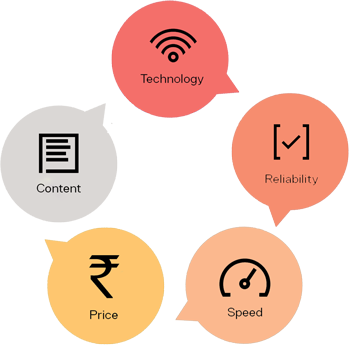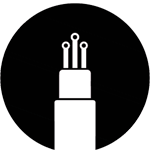Why fiber broadband?
You are putting your hard-earned money to get broadband at your home and Office. Today, broadband is one of the core need for every individual. Roti, Kapda, Makaan and broadband. So, is fiber broadband the best option for you? Let’s do an objective assessment with clear criteria:
Technology:
DSL:
Direct subscriber line is basically internet delivered to on your telephone line. Telephone networks are built on copper wires. While copper is a good conductor, data cannot travel as quickly via telephone lines as it can with fiber optic systems. Speeds are historically the slowest of available internet services. Asymmetrical DSL (ADSL) offers download speeds of up to 15Mbps and upload speeds reaching 512 Kbps. The other DSL variation is Very-high-bit-rate DSL (VDSL), which offers higher speeds of up to 50 Mbps download 6 Mbps for upload speed. The main limitation of ADSL and VDSL is the slow upload speed and inability of download speeds to increase beyond 50 Mbps.
Cable:
People sometimes confuse cable with fiber, cable connection utilizes the coaxial cable that connects to your television set. In contrast to DSL, the quality of a cable connection does not depend on distance so your speed is guaranteed regardless. However, unlike DSL, which runs on a dedicated line, cable connections are typically shared amongst your neighbours, making it a slightly less secure option and because cable Internet works on shared bandwidth, speeds can be affected at times of peak usage. When neighbours use their connections at the same time, speeds may vary. As far as speed goes, cable connection can give you up to 3 times faster speeds than DSL.
Fiber:
Fiber optic connection offers many advantages over conventional copper cable lines. It can transmit data much faster over greater distances. Since the conductor is glass and transmit pulses of light instead of electricity, fiber broadband is immune to outside electromagnetic interference such as lightning or high-voltage power lines. So, with fiber-optic, there is less chance of your computer sustaining lightening related damage. Hundreds or thousands of fine glass fibers can be bundled into a single optic cable. The design allows digital information to travel longer distances with very little degradation. Speeds of a fiber optic connection can reach up to 10 Gbps.
| Criteria | DSL, VDSL, V-Fiber | Cable | Fiber |
|---|---|---|---|
| Reliability | Degradation over longer distances, open to electrical interference | Shared connection, not safe. Speed fluctuates. | No interference, longer distances, easy to maintain |
| Speed | < 50 Mbps download, < 6 Mbps upload | Up to 100 Mbps download. Speed slows down at peak time | Up to 10 Gbps upload and download. Future proof. |
| Price | ~₹26.5 per Mbps. You get a 40 Mbps VDSL (V-Fiber) connection | ~ ₹20 per Mbps. You get a 50 Mbps connection at best | ~₹1.47 per Mbps. You get 1 Gbps connection from Spectra |
| Content | Limited ability to consume video content. You experience buffering because of slow upload and download speed. | Limited ability to consume video content. You experience buffering and your speed slows down at peak times. | Enjoy video content, in 4K on five 4K TVs simultaneously. Buffer free gaming, save faster to the cloud than your USB drive. |
Fiber is future proof. Spectra Fiber broadband connection helps you #MakeLifeBetter by enabling you access to the best digital tools and content for entertainment, education and communication.




